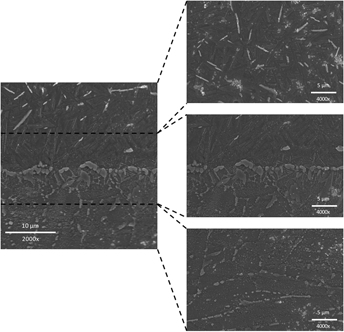Crossref Citations
This article has been cited by the following publications. This list is generated based on data provided by
Crossref.
Avila, Jose D.
and
Bandyopadhyay, Amit
2019.
Influence of boron nitride on reinforcement to improve high temperature oxidation resistance of titanium.
Journal of Materials Research,
Vol. 34,
Issue. 07,
p.
1279.
Dass, Adrita
and
Moridi, Atieh
2019.
State of the Art in Directed Energy Deposition: From Additive Manufacturing to Materials Design.
Coatings,
Vol. 9,
Issue. 7,
p.
418.
Liu, Cansen
Wei, Dongdong
Huang, Xiaoye
Mai, Yongjin
Zhang, Liuyan
and
Jie, Xiaohua
2019.
Electrodeposition of Co–Ni–P/graphene oxide composite coating with enhanced wear and corrosion resistance.
Journal of Materials Research,
Vol. 34,
Issue. 10,
p.
1726.
Thomas, J.
Mogonye, J.E.
Mantri, S.A.
Choudhuri, D.
Banerjee, R.
and
Scharf, T.W.
2020.
Additive manufacturing of compositionally graded laser deposited titanium-chromium alloys.
Additive Manufacturing,
Vol. 33,
Issue. ,
p.
101132.
Balla, Vamsi Krishna
Bodhak, Subhadip
Datta, Pradyot
Kundu, Biswanath
Das, Mitun
Bandyopadhyay, Amit
and
Bose, Susmita
2020.
Biointegration of Medical Implant Materials.
p.
433.
Bandyopadhyay, Amit
Traxel, Kellen D.
Avila, Jose D.
Mitra, Indranath
and
Bose, Susmita
2020.
Biomaterials Science.
p.
257.
Bandyopadhyay, Amit
Traxel, Kellen D.
and
Bose, Susmita
2021.
Nature-inspired materials and structures using 3D Printing.
Materials Science and Engineering: R: Reports,
Vol. 145,
Issue. ,
p.
100609.
Sayedain, Sayed Shahab
Ekrami, Aliakbar
and
Badrossamay, Mohsen
2021.
Production and characterization of Ti6Al4V/CaP nanocomposite powder for powder-based additive manufacturing systems.
Powder Technology,
Vol. 386,
Issue. ,
p.
319.
Afrouzian, Ali
Avila, Jose D.
and
Bandyopadhyay, Amit
2021.
Biotribocorrosion of 3D-printed silica-coated Ti6Al4V for load-bearing implants.
Journal of Materials Research,
Vol. 36,
Issue. 19,
p.
3974.
Svetlizky, David
Das, Mitun
Zheng, Baolong
Vyatskikh, Alexandra L.
Bose, Susmita
Bandyopadhyay, Amit
Schoenung, Julie M.
Lavernia, Enrique J.
and
Eliaz, Noam
2021.
Directed energy deposition (DED) additive manufacturing: Physical characteristics, defects, challenges and applications.
Materials Today,
Vol. 49,
Issue. ,
p.
271.
Xu, Jingyuan
Zhang, Jiawen
Shi, Yangfan
Tang, Jincheng
Huang, Danni
Yan, Ming
and
Dargusch, Matthew S.
2022.
Surface Modification of Biomedical Ti and Ti Alloys: A Review on Current Advances.
Materials,
Vol. 15,
Issue. 5,
p.
1749.
Jagadeeshanayaka, N.
Awasthi, Shikha
Jambagi, Sudhakar C.
and
Srivastava, Chandan
2022.
Bioactive surface modifications through thermally sprayed hydroxyapatite composite coatings: a review of selective reinforcements.
Biomaterials Science,
Vol. 10,
Issue. 10,
p.
2484.
Yu, Hang Z.
2022.
Additive Friction Stir Deposition.
p.
203.
Okolie, Obinna
Stachurek, Iwona
Kandasubramanian, Balasubramanian
and
Njuguna, James
2022.
Material Challenges and Opportunities in 3D Printing for Hip Implant Applications.
Recent Progress in Materials,
Vol. 04,
Issue. 01,
p.
1.
Svetlizky, David
Zheng, Baolong
Vyatskikh, Alexandra
Das, Mitun
Bose, Susmita
Bandyopadhyay, Amit
Schoenung, Julie M.
Lavernia, Enrique J.
and
Eliaz, Noam
2022.
Laser-based directed energy deposition (DED-LB) of advanced materials.
Materials Science and Engineering: A,
Vol. 840,
Issue. ,
p.
142967.
Rogala-Wielgus, Dorota
Majkowska-Marzec, Beata
and
Zieliński, Andrzej
2024.
Characteristics of silver-dopped carbon nanotube coating destined for medical applications.
Materials Today Communications,
Vol. 38,
Issue. ,
p.
107712.
Siddiqui, Muhammad Abdullah Shadab
Mia, Md Palas
Hossain, Md Abdul Kabir
Rabbi, Md. Sanaul
Butt, Haider
and
Alam, Fahad
2025.
Recent Advances in Crystalline Architecture and Defect Engineering of 3D‐Printed Metals for Biomedical Breakthroughs: A Comprehensive Review.
Advanced Engineering Materials,
Vol. 27,
Issue. 16,
Al-Mahmood, Muslim
Sakhi, Said
Abuzaid, Wael
Alkhader, Maen
and
Alnaser, Ali S.
2025.
Synergistic integration of carbon nanotubes in laser powder bed fusion: advancing multifunctional metal additive manufacturing.
Journal of Materials Science,
Vol. 60,
Issue. 33,
p.
14279.


